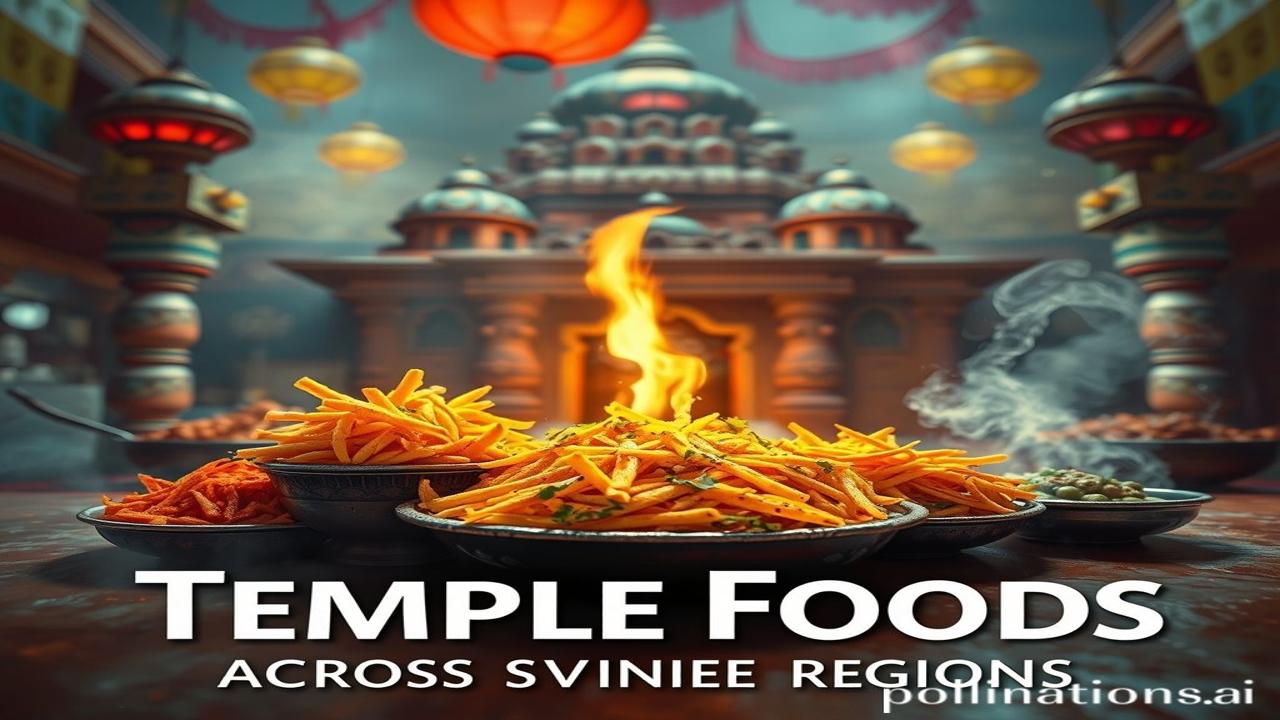Mandir Ki Rasoi: A Culinary Journey Through India’s Temple Foods
Kabhi socha hai, bhagwan ko bhog lagane ke baad jo prasad milta hai, usme kitni kahaniyaan chupi hoti hain? Stories of devotion, history, and the soul of India itself. Aaiye, aaj hum chalte hain ek aisey safar par, jahan har daana, har swaad, ek itihaas hai – a culinary pilgrimage through the diverse world of temple foods across India.
The Sacred Kitchen: A Glimpse into History
Temple food, or “prasad,” is more than just edible offerings. It’s an intrinsic part of Indian culture, dating back to ancient times. Think about it: Since the Vedic era (around 1500-500 BCE), food offerings were integral to yajnas (sacrificial rituals). Over time, as temples evolved into complex institutions, so did the culinary traditions associated with them.
Yeh prasad sirf bhagwan ko nahi, balki hamari sanskriti ko bhi samarpit hai. Every region developed its own unique style, influenced by local ingredients, customs, and the presiding deity. Each mandir is a repository of ancient recipes passed down through generations, a living testament to our culinary heritage.
Why Temple Food Matters: It’s More Than Just a Meal
Temple food isn’t just about satisfying hunger; it’s about bhakti (devotion) and seva (service). It embodies the principle of Anna Daan – the donation of food, considered one of the highest forms of charity in Hinduism.
It brings communities together. Festivals and temple celebrations revolve around the preparation and distribution of prasad, strengthening social bonds. It also offers a glimpse into the dietary habits of the region, highlighting indigenous ingredients and cooking techniques.
Life in the Temple Kitchen: A Day in the Life
Imagine yourself stepping into the bustling kitchen of the Jagannath Temple in Puri, Odisha. It’s dawn, and the air is thick with the aroma of woodsmoke and spices. Hundreds of cooks, or Suaras, are already hard at work, preparing the famous “Mahaprasad.”
“Arrey Ramu kaka, chawal jaldi lao!” shouts a young Suara, his face flushed with exertion. The rhythmic clang of pots and pans fills the air, a symphony of culinary activity. Strict rules govern the preparation – everything must be cooked in earthen pots over a wood-fired oven, maintaining the purity and sanctity of the food.
Ma Rukmini, the wife of a head cook, lovingly prepares a special dish of “Dalma” (a lentil and vegetable stew), whispering prayers as she adds each ingredient. Her husband reminds her, “Aaj toh Prabhu Jagannath ko chappan bhog lagega, Rukmini! Hamein koi kasar nahi chhodni hai.” He smiles, knowing that their dedication is a form of worship in itself.
Across the Regions: A Taste of India’s Divine Cuisine
Let’s journey across India and sample some of the most iconic temple foods:
-
Puri, Odisha (Jagannath Temple): The Mahaprasad is legendary, consisting of 56 different dishes offered to Lord Jagannath. It includes rice, dal, vegetables, sweets, and even dried rice, all prepared without using garlic or onions. The entire kitchen is run by hereditary cooks, maintaining centuries-old traditions.
-
Tirupati, Andhra Pradesh (Venkateswara Temple): Who hasn’t heard of the Tirupati Laddu? These melt-in-your-mouth spheres of gram flour, sugar, ghee, and dry fruits are a must-have for every pilgrim. Millions of laddus are made daily, a testament to the temple’s popularity.
-
Mathura-Vrindavan, Uttar Pradesh (Krishna Temples): The land of Lord Krishna is known for its rich dairy products. Expect creamy lassi, buttery peda, and delectable rabri. Each temple has its own unique recipe, adding to the culinary diversity of the region.
-
Amritsar, Punjab (Golden Temple): The Langar at the Golden Temple is a symbol of Sikh generosity and equality. Free meals are served to anyone, regardless of caste, creed, or religion. The menu typically includes dal, roti, sabzi, and kheer, all prepared with love and devotion.
Modern Echoes: Temple Food in Today’s India
Even in today’s fast-paced world, the traditions of temple food remain alive and well. Many temples continue to offer free or subsidized meals to pilgrims and the needy, upholding the spirit of Anna Daan.
You’ll find elements of temple cuisine influencing modern Indian cooking. Chefs are drawing inspiration from ancient recipes and techniques, incorporating them into their menus. The emphasis on fresh, seasonal ingredients and traditional methods is making a comeback, reflecting a renewed appreciation for our culinary heritage.
This is our Bharatiyata – the spirit of India – being passed down through generations, one bite at a time.
Fun Fact or Myth-Buster
Myth: Temple food is bland and lacks variety.
Truth: While some temple recipes may be simple, they are far from bland. The use of carefully selected spices, aromatic herbs, and traditional cooking methods elevates the flavors to a divine level. The sheer variety of temple foods across India is astounding, with each region offering its own unique culinary treasures.
The Sounds, Smells, and Sights
Imagine standing in the courtyard of a South Indian temple. The air is filled with the fragrance of jasmine flowers and burning incense. The rhythmic chanting of priests echoes through the halls. You feel the cool smoothness of the stone floor beneath your feet. As you accept the prasad – a small portion of sweet pongal – you can taste the richness of ghee and the subtle sweetness of jaggery. It’s a sensory experience that connects you to something bigger than yourself.
A Closing Thought
Annadaanam param daanam, vidya daanam atah param.
(The donation of food is the best donation; the donation of knowledge is even higher.)
Let us remember the significance of food as a symbol of sharing, compassion, and devotion. The legacy of temple food is a testament to the richness and diversity of our culture, a legacy we must preserve and cherish for generations to come.
